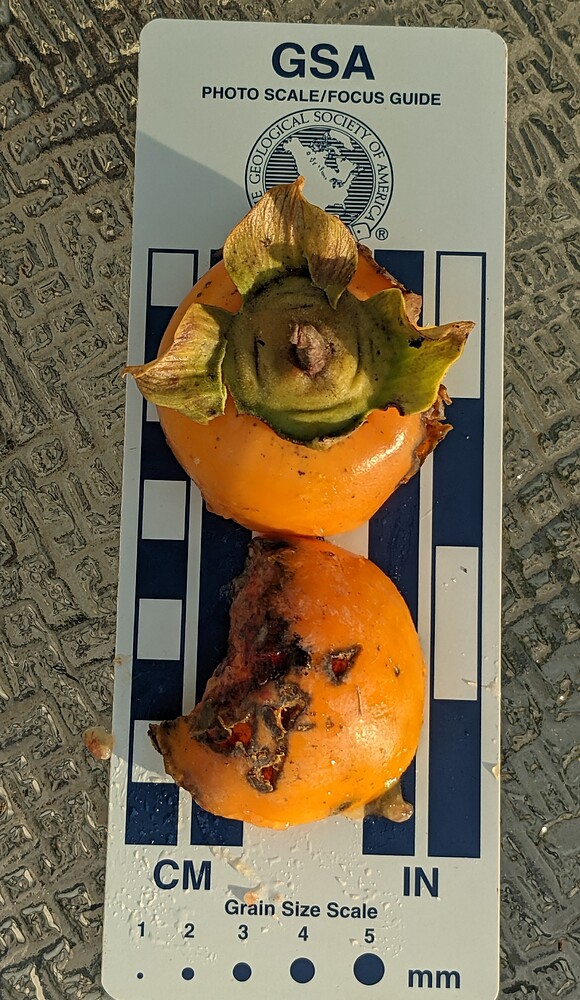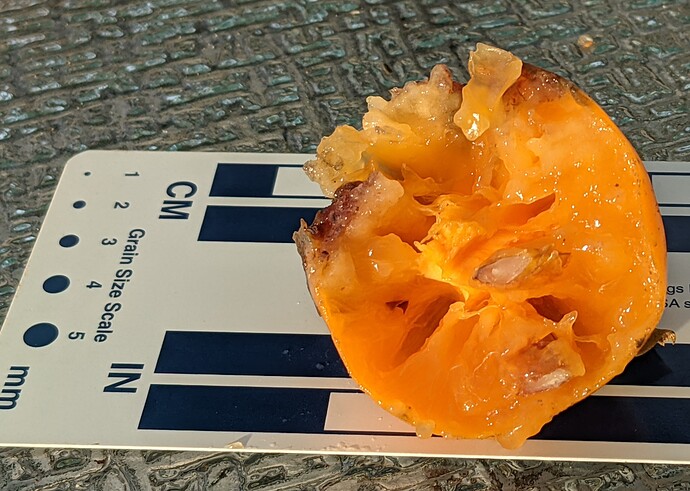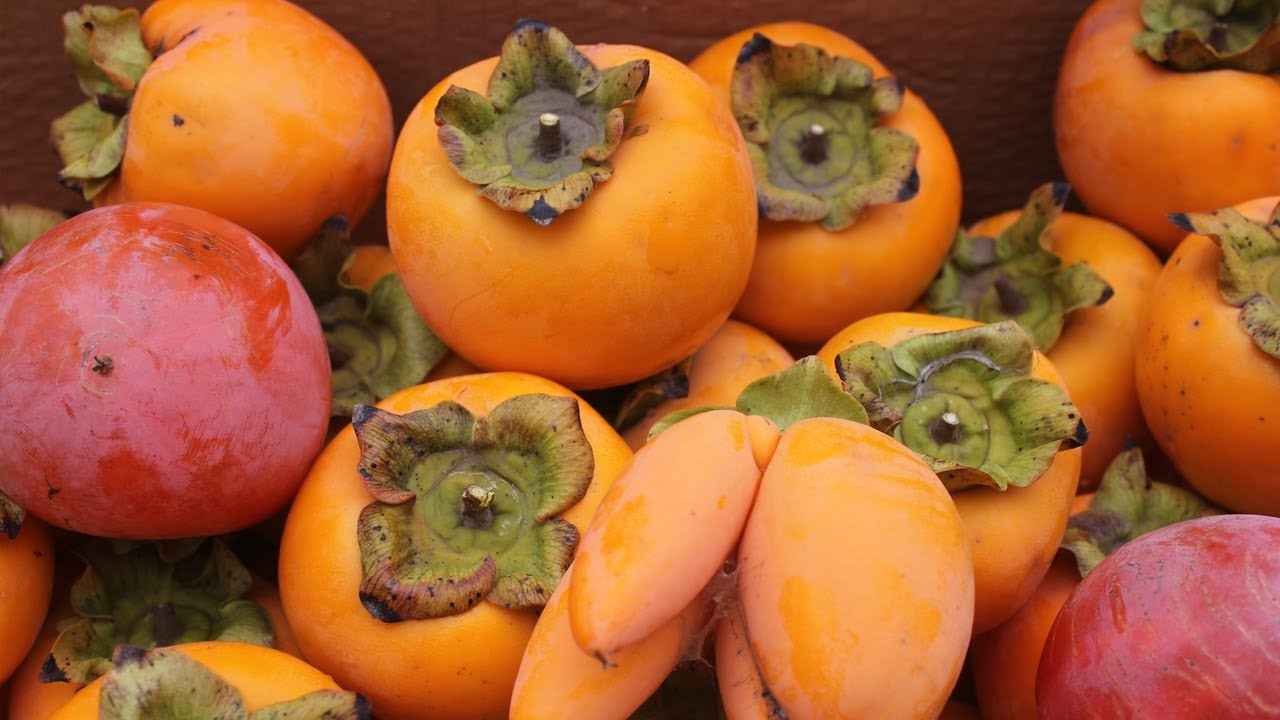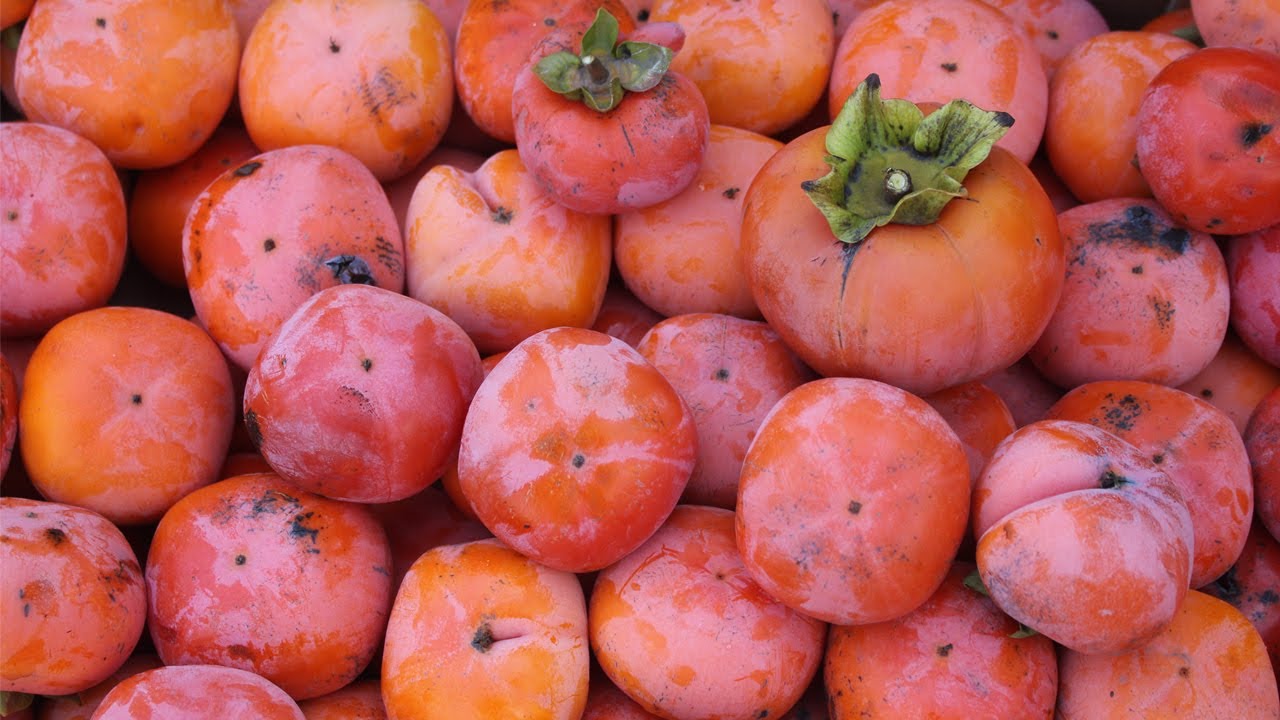I tried CO2 treatment on my first 3 Nikita’s Gift fruit for ~72 hours. All the kakis in the same batch were non-astringent by that time (after sitting out overnight after removing from the CO2), but the Nikita’s Gift fruit were still too astringent to eat. I didn’t have more fruit to experiment further.
This raises an interesting question – Whether astringency is the same in Asians and Americans / hybrids. From what I remember, the reported successes with CO2 or alcohol involved astringent Asians. For example, CO2 is used commercially with the astringent Asians sold as Sharon and Rojo Brillante. Others (but not all) have reported success with the astringent Asian Hachiya. On theater hand, I had no success using alcohol do remove astringency from the American Prok. @ncdabbler is having difficulty using CO2 with the hybrid Nikita’s Gift.
Do others interpret the reported results similarly?
I’m glad to hear it, and thanks for reporting back. I’m still looking forward to eventually tasting Saijo. I have a young tree growing well, after first getting sent a mislabeled tree, then having no success grafting it.
I’ve currently got 3 Hachiya (or at least labeled as such at the produce store) that I vacuum sealed yesterday. I’ve noticed that they’ve slackened in the bag, either a slight leak, or more likely, some precipitated gases from the fruit.
In a rigid container, you may be able to use softer fruit without squishing it. I think I gave away our containers because we rarely, or never, used them and we lack space for things - especially that we may not be able to find when we want to use them.
After a few hours that happened to 1 of my bags. Since the other 4 remained vacuum tight, it seemed to be a leak. I resealed it and it remained vacuumed.
With this next batch I’m reducing the days in the vacuum state to find the minimum # days.
Also going to keep some in the vacuumed state for two weeks to see if it would be a feasible to stagger the fruit for fresh eating.
I, too, gave away all my rigid vacuum containers. Will have check the thrift stores and buy one back!
CO2 treatment works for kaki and doesn’t work for virginiana. With hybrids it is more complicated. It seems that those with predominant kaki genes respond to CO2 quite well and those that are somewhat in the middle or closely related to virginiana remain astringent until fully soft.
@Harbin – Thanks. Of course now you’ve fed the beast and it wants more:
Do you know if it’s the same for alcohol?
Do you know if there is there any published scientific literature on this topic? It seems likely that agricultural companies in Spain and Israel, where the CO2 process is used on a massive scale, would have conducted some serious research, though they might not have published it.
Among the hybrids, is there a breakdown soimnewhere re which work and which don’t? For example, in the video linked just above, Kasandra looks American whereas Mikkusu looks Asian. Is that any clue?
@jrd51 this is just my humble observation, nothing scientific in it. In my experience alcohol vapors work about as similar as CO2 but for the home use alcohol gives better results, it is cheaper and easier to use.
There are many papers on the Deastringency process using CO2. But all of them are dealing with D.kaki and none with hybrids or american persimmon.
Among the hybrids it is pretty much “trial and error” thing.
@Harbin –
Don’t get me wrong, your “humble observation” is exactly what I was soliciting. I’m grateful.
As you may have noted, I tried to reduce astringency in the American variety Prok – with no success. So my very limited (and also very humble) observations are consistent with yours.
I think we should try to collate results for the “trial and error” with hybrids. I may start a separate thread.
Anyone have access to the Pomona archives? I found the following citation in a dissertation online. From how they use the citation in the text, it sounds like they hadn’t nailed removing astringency, but they might have some good leads or at least some more insight into what’s going on.
Griffith , E. 1972. Removing astringency from American persimmons. Pomona 5: 85-87.
In my first experience this year Chienting is hard to get rid of astringency. We had several nights with temperature ~ 26° Fahrenheit last week. While Giombo fruits are not affected by freezing and one which became fully ripe was excellent, some Chienting fruits look like parts of them were frozen (which I don’t like).
I think next year I would try to pick them before hard freeze and place into cardboard boxes in a cold closed porch.
“putting a little dish of 80 proof or higher alcohol (vodka, etc.) in a closed bag or container”
I think I’m going to try this method for Chienting persimmons. I have 75% neutral grain alcohol from Total Wine - used it to make Umeshu from my Prunus mume tree. By the way, Umeshu is super-tasty and super-easy liquor to make. And Prunus mume is beautiful and easy to grow tree.
An update (I know @DennisD also wants to know about this one)… I’ve knocked on their door a few times, but either no one’s home or they don’t answer their door. I did find a fruit that a squirrel (presumably) carried into the alleyway to nibble, so I picked that up to photograph more closely. It had more seeds than I was expecting (9+):
I’ll keep trying their door until they answer, and will update when/if that ever happens.
it seems to have seeds, i dont this is a non astigent but rather an astrigent type. for the shape looks similar to maru
Can confirm, I licked it and it’s still a bit astringent despite being pretty soft, and it had at least 8 or 9 seeds
A friend of mine has a persimmon tree but he lost the tag and can’t remember what variety is it. The persimmons are astringent and have seeds, here are some pictures of the tree and the persimmons hopefully someone can help identify what variety is it.
Thanks Winn,
Can’t help with ID, but chances are it’s not Asian.
Hi i am from Serbia and i grow persimmons for years now.
This is how persimmons looked like this year.I grow only Asian type of persimmons.
Thees are two different varieties.
Darn it! I’ve spent the last few weeks wondering if you ever got a fresh Saijo and if so how you liked it! THen today I stumble across your post 22 days ago reporting on it. You even tagged me and I still somehow missed it! I felt like I’d pushed Saijo to you so long and so hard and asked so many times that I just hated to keep on. haha. But it sounds like I didn’t oversell it so badly that your expectations were to high to be fulfilled and you actually did like it. What was fun for me was how much your brief description agreed with my own experience! I cannot tell you how many times I’ve used the words Jell-O or Jello-like to describe this fruit to others! It really is the closest thing I can think of to explain the texture. And just like you said, that Jello-like texture is quite different from all other persimmons I’ve ever tried (I’ve tasted 8 other varieties). The closest is Nakita’s gift…but even it isn’t quite as “Jello-like” in the texture of the fruit. It is this texture AND the extreme sweetness that makes Saijo Persimmon one of my top 2-3 fruits I grow. Not just my top persimmon, but my top 2-3 fruits period.
To answer your question, I almost never loose my leaves to frost before almost all my Sajios are ripe and picked. It deeply, deeply saddens me to hear that is the case with your location! It hurts me so bad to hear that because - and you alluded to this- once frost kills the leaves it completely changes the way they ripen and the degree to which they ripen and (related) how sweet they are. As I’ve told you, in normal times (mean before frost kills and drops leaves), my Saijos get to a deep orange color before they ripen, then they ripen in a single day (not the whole tree- I mean individual fruits first get deep orange in color, then they go from hard all over to completely soft in a day- individually). But once the leaves fall from the tree, its different. First, they no longer really get a deep, solid orange color before ripening. They look much more like the whole one shown in your photo. Even more importantly, though, once the leaves get frost bitten and dry and crumbly and then fall, the fruit take FOREVER to ripen. FOREVER. They can stay stuck in the same pre-ripened state for WEEKS sometimes. And when they do ripen, it isn’t as I’ve explained before and again here- ie they don’t go from hard to soft in a day. They ripen much more like other varieties…they slowly start to soften at the tip and then over a few days it spreads until they feel soft all over but even then I sometimes cut them open and find the top or the very center is still a bit under ripe. In the photo you show above of your cut saijo, it has that light colored core running right down the center. That part- even if you didn’t notice it- is actually still very slightly unripe and a tiny bit astringent. You rarely see that if they ripen pre-leaf drop. By the time those pre-drop fruit get soft, they are ripe to the core. I’m sure that tiny string of very lightly astringency didn’t hurt the taste nor did you probably even realize it had some slight astringency left. But if you’d tasted it by itself you’d likely have been able to taste just a trace of astringency. The only reason I even note it here is because seeing it tells me something else. When my fruit have that little string/core of unripe/astringent flesh in the center, it also is the case that the whole fruit hasn’t reached absolute maximum ripeness and (more importantly) sweetness. It’s not markedly less sweet, but it is a little under the peak.
In typical @thecityman style, I’ve blathered on way too long and gave way too many unimportant details! ha. But I feel like I’ve been through your entire Saijo journey with you from the time I first started begging you to grow one, and also because I’m such a nut about Saijo and feel it really is substantially different - and BETTER- from all other persimmons. So I guess I’m just running my own little Saijo Promotional Campaign and trying to get all the information I can out there. I am sorry to hear that your location means you may never get Saijos that ripen “normally” with leaves on the tree and weather still fairly warm (not sure the temperature part matters) but it doesn’t mean you won’t still be getting great fruit each year. Its just that you may have to settle for a 9.5 instead of a 10 - which no one but me would think is sad! haha.
Glad you got some, glad you liked them. You mentioned some Saijo hybrids. I hope you try some. I don’t know which other persimmons are Saijo hybrids (I know Nakitas gift is an American/Asian Hybrid, do you know if Saijo is the Asian part of that hybrid? I wouldn’t be surprised since its the closest thing I’ve had to Saijo.) Either way, I’d be interested in knowing the names of any Saijo hybrids if you know them. And even more interested in hearing from you or others who have tried them.
Glad you finally got to try a Saijo, and I’m even happier than you liked it ! Thanks for letting me be part of your journey!
Just putting this persimmon candy recipe here so I can find it again in 3-5 years when my trees are (hopefully) producing.
Looks good, I love caramel.
I wouldn’t trust the website to still have the recipe in three years or so when you think of it. I’d print it out and put into your recipe box.






